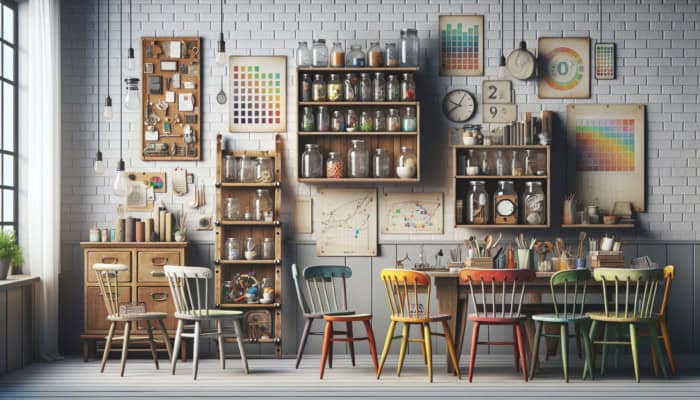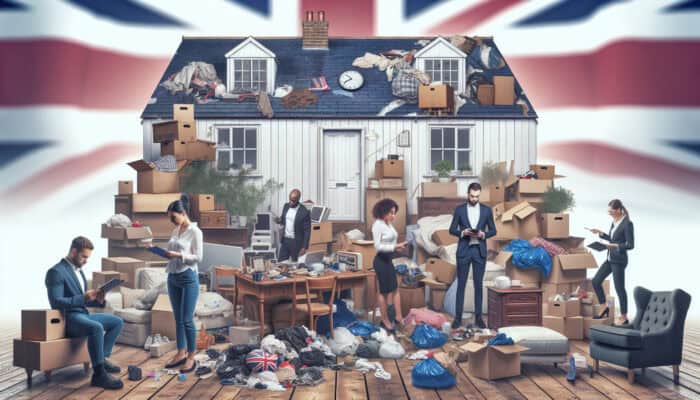Essential Eco-Friendly Strategies for Budget-Conscious House Clearance
Embarking on a house clearance can often seem daunting, particularly when you factor in the potential environmental impact of your decisions. However, by adopting a strategic approach grounded in budget eco-friendly strategies for house clearance, you can create a more organised living environment while positively contributing to the planet. Let’s explore key strategies to guide you through this process without straining your finances.
Maximise Reuse of Household Items to Minimise Waste

One of the most effective methods to reduce waste during a house clearance is maximising the reuse of existing household items. Before discarding anything, please take a moment to evaluate its potential for repurposing. Many everyday household items can have multiple uses. For example, glass jars can easily be transformed into storage containers for pantry staples or craft supplies. At the same time, outdated furniture can be rejuvenated with creativity and DIY effort.
Consider establishing a designated area in your home for collecting items that can be reused. This approach not only helps you stay organised but can also ignite your creativity for new uses. An old ladder could be reimagined as a distinctive bookshelf, or mismatched chairs might be painted and assembled into a charming dining set. By actively seeking opportunities to reuse what you already possess, you can significantly reduce the waste sent to landfills, making clearing efforts more eco-friendly.
Support Local Charities by Donating Unwanted Items
Donating items to local charities is a compassionate way to declutter your home while positively impacting those in need. Many charities eagerly accept gently used clothing, furniture, electronics, and household goods. This initiative not only assists you in decluttering efforts but also enriches the community by providing essential resources to individuals who may be unable to afford new items.
Before starting your house clearance, take the time to research local charities that resonate with your values. Many organisations offer convenient collection services, simplifying the process of donating larger items like furniture. Additionally, be on the lookout for specific donation drives in your area, as these present excellent opportunities to contribute while clearing out your home. Please record your donations, as they may qualify for tax deductions, providing further financial benefits while endorsing sustainable practices.
Utilise Online Platforms for Selling Unwanted Items
In our digital age, selling unwanted items has become more streamlined than ever, thanks to various online platforms. Websites and applications like eBay, Facebook Marketplace, and Gumtree enable you to connect with potential buyers in your local area and beyond. This helps you recoup some of the costs associated with your budget eco-friendly strategies for house clearance and ensures that your items find a new home instead of ending up in a landfill.
To enhance your sales potential, take high-quality photographs of your items and create detailed descriptions that showcase their features and condition. Pricing can be challenging; researching similar items online can help you set a fair price. Transparency about wear and tear is crucial for building trust with potential buyers. By investing time in selling unwanted items, you reduce clutter and promote a circular economy where goods are reused and recycled effectively.
Understanding Recycling for Sustainable House Clearance

As you embark on your house clearance journey, grasping the significance of recycling can significantly influence your environmental footprint. By incorporating budget and eco-friendly strategies for house clearance, you can ensure that materials are disposed of responsibly, contributing to a more sustainable future.
Identify Local Recycling Centres for Responsible Disposal
Becoming familiar with your local recycling centres is critical in your house clearance process. Each centre has specific regulations concerning the materials they accept, ranging from plastics and metals to paper and cardboard. Before packing, compile a list of items you intend to recycle and verify which centres can accommodate them. This proactive approach saves you time and guarantees that your efforts align with eco-friendly practices.
Many recycling centres also designate special collection days for hazardous materials, including batteries, paint, and electronics. Handling these items carefully is vital, as improper disposal can adversely affect the environment. By understanding your local options and their requirements, you can ensure that your materials are appropriately recycled, minimising overall waste and fostering a sustainable community.
Engage Specialist Recycling Services for Electronics and Hazardous Waste
Not every item can be placed in your regular recycling bin, especially electronics and hazardous waste. These materials necessitate specialised handling to prevent environmental damage. Seek out local services specialising in recycling electronics, as many provide free drop-off locations or even pick-up services for larger items like televisions and computers.
Hazardous waste, including chemicals and batteries, requires careful disposal. Investigate local agencies or organisations that offer guidance on safe disposal methods. Many communities host periodic hazardous waste collection events, which can be an excellent opportunity to dispose of these materials responsibly.
By utilising specialist recycling services, you not only safeguard the environment but also inspire others to do the same, spreading awareness about the importance of responsible disposal.
Transform Old Furniture Through Upcycling Projects

Upcycling is a creative and rewarding approach to revitalising old furniture and household items that would otherwise be discarded. Instead of simply disposing of that worn-out chair or dated dresser, contemplate how to transform it into something functional and stylish. Upcycling mitigates landfill waste and allows you to express your creativity and personal style.
There is no shortage of online resources, from blogs to YouTube tutorials, that can guide you through various upcycling projects. For example, an old wooden pallet can be converted into a rustic coffee table, or an unused suitcase can be transformed into a chic side table. The possibilities are limitless, and the fulfillment of creating something new from what could have been considered waste is incredibly satisfying.
Moreover, by embracing upcycling, you contribute to a more sustainable lifestyle that prioritises creativity and resourcefulness. Every project you undertake enhances your home’s character and exemplifies your dedication to eco-conscious living.
Effective Budget Planning for Eco-Friendly House Clearance
Planning your house clearance with a clear budget is vital for achieving a successful and stress-free experience. By employing budget eco-friendly strategies for house clearance, you can make informed decisions to keep your finances on track while ensuring your clearance aligns with eco-friendly practices.
Create a Detailed Budget for Your Clearance Efforts
Formulating a comprehensive budget for your house clearance is the foundation of a successful endeavor. Begin by listing all potential expenses, such as transportation costs, disposal fees, and materials needed for packing or repairs. This will provide you with a clear understanding of the financial commitment and help you avoid unanticipated costs.
Consider reserving a portion of your budget for donations or sales. For instance, if you plan to donate items, you may need to factor in transport or storage solutions. By anticipating these costs and integrating them into your budget, you can minimise stress and facilitate a smoother clearance process.
Additionally, keep track of your expenditures throughout the clearance. This practice will help you stay accountable and allow for adjustments if necessary. By proactively managing your budget while endorsing eco-friendly practices during your house clearance, you can effectively oversee your finances.
Evaluate DIY Versus Professional Services for Clearance
As you plan your house clearance, a significant decision you’ll face is whether to manage it yourself or enlist professional services. Each option has advantages and disadvantages, which can help you make the best choice for your situation.
Choosing a DIY clearance can save you money, particularly if you have the time and energy to dedicate to the task. It allows you complete control over the process, ensuring your eco-friendly practices are strictly adhered to. However, consider the potential time investment and physical labor required, which can be overwhelming, especially for larger homes.
Conversely, hiring professionals can significantly streamline the process. They possess the expertise and resources to handle items safely and responsibly, including recycling and disposal. Nevertheless, this option typically comes at a higher cost. Weigh your circumstances, including your budget, available time, and physical capacity, to determine the best course of action for your house clearance.
Strategise Your Time Management for a Thorough Clearance
Effective time management is essential for a successful house clearance. Rushing through the process can lead to errors, overlooked items, and a less eco-friendly outcome. Start by creating a structured schedule, breaking the clearance into manageable tasks. This includes sorting items, packing, and arranging donations or pickups.
Establish realistic deadlines for each task, allowing ample time to reflect on what to retain, sell, or discard. Consider enlisting the help of friends or family to make the process more enjoyable and efficient. Not only will this lighten your workload, but it can also provide emotional support, making it easier to part with belongings that may hold sentimental value.
By approaching your house clearance with a well-structured plan, you can ensure a thorough and thoughtful process that aligns with your eco-friendly objectives while remaining within your budget.
Implement Sustainable Packing Solutions for House Clearance
Packing is a crucial aspect of the house clearance process, and selecting sustainable packing solutions can significantly reduce your environmental impact. Using budget eco-friendly strategies for house clearance, you can opt for eco-conscious materials and techniques that promote sustainability without straining your wallet.
Choose Biodegradable and Reusable Packing Materials
Opting for packing materials that are biodegradable or reusable is a great way to enhance your house clearance efforts. Traditional bubble wrap and plastic packing peanuts are far from eco-friendly. Instead, consider using biodegradable materials such as recycled paper, cardboard boxes, or natural fabrics like cotton or linen. These alternatives are better for the environment and often more cost-effective than their plastic counterparts.
You might also explore local stores or online marketplaces for second-hand packing supplies. Many individuals sell or give away boxes and packing materials after their moves, presenting a perfect opportunity to reuse items that would otherwise be discarded. By selecting eco-friendly packing materials, you can significantly reduce your carbon footprint while ensuring your belongings are safely transported during clearance.
Embrace Minimalist Packing Techniques for Efficiency
Minimalist packing techniques can save money and materials during your house clearance. Start by evaluating your items and considering how to pack them more efficiently. For instance, nesting items within one another, such as stacking cups and placing smaller items inside larger ones, can optimise space and decrease the number of boxes required.
Additionally, consider packing by category and grouping similar items. This simplifies unpacking and helps you identify items that may no longer serve a purpose in your life. By embracing a minimalist approach to packing, you can streamline your clearance process while maintaining a commitment to sustainability.
Repurpose Old Clothes and Linen as Packing Materials
Rather than purchasing new packing materials, use the resources you already have at home. Old clothes, towels, and linens can serve as excellent packing materials, providing cushioning for fragile items and reducing the need for plastic bubble wrap. This not only helps you save money but also ensures you are maximising what you already own.
When packing, wrap delicate items in soft fabrics to protect them during transport. This safeguards your belongings and adds a personal touch to your packing process. Repurposing household items can significantly minimise waste and create a more eco-friendly house clearance experience.
Enhancing Community Engagement to Support House Clearance
Engaging with your community can enrich your house clearance experience while fostering environmental sustainability. By sharing resources and ideas, you can cultivate a sense of camaraderie and collaboration, amplifying the impact of your budget-friendly house clearance strategies.
Organise Neighbourhood Swaps for Sustainable Item Exchange
Neighbourhood swaps present a fantastic opportunity to declutter your home while nurturing community spirit. By organising or participating in local item exchange events, you can connect with neighbors and trade items you no longer need for things that might be useful to you. This promotes sustainability and fosters a sense of community, as everyone benefits from shared resources.
To initiate a neighbourhood swap, start by reaching out to friends and neighbors to assess interest. Set a date and location, then promote the event through social media or local community boards. Make it a fun gathering by including refreshments and activities, transforming the swap into a social event that brings everyone together.
Participating in or organising neighbourhood swaps contributes to a culture of reuse and sustainability, reinforcing the notion that we can collectively work towards reducing waste.
Participate in Community Clearance Days to Promote Sustainability
Many communities host clearance days focused on decluttering and recycling. Getting involved in these initiatives not only helps you clear out your home but also allows you to contribute to a more significant cause. Community clearance days typically involve collaborative efforts to clean up shared spaces, recycle materials, and raise awareness about sustainable practices.
Look into local events and consider teaming up with friends or family to make a day of it. Not only will you be assisting your community, but you’ll also gain valuable insights into eco-friendly practices that you can apply to your house clearance.
Engaging in community clearance days fosters collaboration, encouraging others to adopt sustainable practices while working towards a cleaner, greener environment.
Educate Your Neighbors on Eco-Friendly Clearance Practices
Once you’ve successfully navigated your house clearance, consider sharing your experiences and knowledge with your neighbors. Education is a powerful tool for promoting sustainability, and your insights can inspire others to adopt eco-friendly practices in their own lives.
Host a casual gathering or workshop where you can share budget eco-friendly strategies for house clearance, including your preferred donation options, recycling insights, and packing techniques. Providing practical examples and resources will empower others to make informed decisions during their clearances.
By nurturing a culture of sustainability in your community, you enhance your eco-friendly practices and contribute to a collective effort towards a more sustainable future. Encouraging others to embrace these values creates a ripple effect that benefits individuals and the environment.
Legal and Safety Considerations for House Clearance
Being aware of the legal and safety considerations involved is crucial when undertaking a house clearance. By following budget and eco-friendly strategies for house clearance, you can ensure that your efforts comply with local regulations while prioritising personal safety.
Stay Informed on Local Waste Disposal Regulations
Understanding local waste disposal regulations is essential for conducting an eco-friendly house clearance. Each locality has specific laws governing what can be discarded and the methods for disposing of various materials. Familiarise yourself with these regulations to avoid fines and guarantee that your waste is disposed of responsibly.
Many local councils offer recycling and waste disposal guidelines, including information on hazardous materials. Adhering to these regulations ensures that your clearance aligns with eco-friendly practices and contributes to a healthier environment.
Additionally, consider contacting your local council for available resources or community initiatives that promote sustainable disposal methods. Staying informed allows you to navigate your house clearance confidently, knowing you’re acting within the law while prioritising sustainability.
Prioritise Safety Gear for Handling Hazardous Materials
Safety should always be paramount during your house clearance, especially when dealing with potentially hazardous materials. Items like chemicals, old paint, or broken glass can pose serious health risks. Invest in essential safety gear, including gloves, masks, and sturdy footwear, to safeguard yourself while handling these materials.
Before starting the clearance, conduct a comprehensive assessment of the items in your home. Identify any hazardous materials and take appropriate precautions when handling them. If you’re uncertain about how to dispose of certain items safely, consult local guidelines or seek assistance from professionals specialising in hazardous waste disposal.
By prioritising safety during your house clearance, you can ensure a smooth and responsible process that protects yourself and the environment.
Review Insurance Coverage for Potential Damages
Before commencing your house clearance, review your home insurance policy to determine if it includes coverage for any potential damages that might occur during the process. Understanding your coverage will provide peace of mind and ensure you’re protected in accidents or mishaps.
If your insurance policy does not cover clearance activities, consider discussing options with your provider. They may offer additional coverage or advice on protecting yourself during the clearance.
Being proactive about insurance coverage allows you to focus on the task without the added stress of potential financial repercussions. This careful planning aligns with your commitment to eco-friendly practices, ensuring your house clearance is conducted responsibly and safely.
Long-Term Sustainability Strategies Post-Clearance
As you complete your house clearance, thinking beyond the immediate task is vital. Implementing strategies for long-term sustainability can help you maintain a clutter-free and eco-friendly home. With budget eco-friendly strategies for house clearance, you can cultivate a lifestyle that prioritises sustainability and reduces future clearance needs.
Future-Proof Your Home to Reduce Future Clearance Needs
To future-proof your home, consider implementing changes promoting sustainability and minimising the accumulation of unnecessary items. Begin by adopting a minimalist mindset, consciously choosing to keep only what you truly need and cherish. Regularly assess your belongings and make decluttering a habitual practice to prevent the reaccumulation of items.
In addition, invest in high-quality, durable, and versatile items rather than transient or trend-driven products. This not only reduces waste but also saves money over time. By making intentional choices about what enters your home, you can create a sustainable environment that requires less frequent clearance.
Incorporate Sustainable Living Practices into Your Routine
Integrating sustainable living practices into your daily life can significantly diminish the need for future clearances. Simple habits, such as shopping mindfully, avoiding impulse purchases, and embracing a “one in, one out” policy, can help maintain a clutter-free space.
When shopping, prioritise second-hand items or eco-friendly products that align with your values. This approach not only reduces waste but also supports a circular economy. By adopting these sustainable practices, you cultivate a lifestyle that values quality over quantity, resulting in fewer items requiring clearance.
Commit to Continuous Improvement in Your Clearance Strategies
Sustainability is an ongoing journey that demands consistent effort and reflection. Regularly review your clearance strategies and assess their effectiveness. Are there areas where you can enhance your approach? Are your practices aligned with your eco-friendly goals?
Consider maintaining a journal or log of your clearance efforts, documenting what worked well and could be improved. This practice will help you stay accountable and make necessary adjustments. Committing to continuous improvement ensures that your house clearance practices remain effective and eco-friendly over time.
Leverage Technology and Apps for Efficient House Clearance
Technology can be a valuable ally in your house clearance endeavors in our increasingly digital world. By utilising budget eco-friendly strategies, you can leverage apps and online platforms to streamline the process and enhance sustainability.
Utilise Clearance Apps to Track Progress and Find Eco-Friendly Options
Several mobile apps are designed to assist with house clearances, helping you monitor your progress and discover eco-friendly disposal options. Applications like “Decluttr” enable you to sell or donate items quickly, while others provide information on local recycling centres and donation locations.
These apps can streamline your house clearance process, making it more efficient and organised. Set clearance goals and utilise the apps to track your achievements, keeping you motivated throughout the journey.
Online Marketplaces for Efficient Selling and Donation of Items
Online marketplaces have revolutionised the way we sell and donate items. Platforms such as eBay, Facebook Marketplace, and Freecycle allow you to connect with potential buyers or individuals in need quickly and efficiently. By leveraging these technologies, you can effectively clear your home of unwanted items while contributing to a more sustainable community.
When posting items online, take the time to craft compelling descriptions and high-quality images to attract buyers. By utilising these digital platforms, you reduce clutter and promote a culture of reuse and sustainability.
Virtual Assistance Tools for Planning and Managing Your Clearance
Virtual assistance tools can significantly enhance your house clearance experience. Use project management apps like Trello or Asana to create to-do lists, set deadlines, and monitor your progress. These tools can help you stay organised and focused, ensuring that you systematically tackle each aspect of your clearance.
Additionally, consider using video calls with friends or family for support and accountability during your clearance. By leveraging technology, you can create an efficient, organised, eco-friendly house clearance experience that aligns with your values.
Addressing Emotional and Psychological Aspects of House Clearance
House clearances can evoke a range of emotions, particularly when parting with sentimental items. Understanding this process’s emotional and psychological aspects can help you navigate your clearance more smoothly. By applying budget eco-friendly strategies for house clearance, you can approach this journey mindfully, prioritising your mental well-being and sustainability.
Strategies for Letting Go of Items with Emotional Attachment
Parting with items can be one of the most challenging aspects of a house clearance, especially if they carry sentimental value. To manage these emotions, consider employing strategies to honor your memories while making sustainable choices.
Begin by designating specific items that you genuinely cherish and wish to keep. For everything else, ask yourself whether the item adds value to your life or if it would be better off with someone else. Remember that memories exist independently of physical objects, and releasing items can create space for new experiences and opportunities.
If you find it especially difficult to part with certain belongings, consider photographing them before letting them go. This way, you preserve the memory without the physical clutter, allowing you to move forward with a lighter heart.
Recognise the Psychological Benefits of a Clutter-Free Home
The psychological advantages of decluttering are significant. They often lead to enhanced feelings of calm and control within your living space. A clutter-free home fosters a sense of order and clarity, enabling you to concentrate on what truly matters.
Research indicates that a tidy, organised environment can reduce stress and anxiety, making it easier to focus and be productive. By prioritising an eco-friendly approach to your clearance, you benefit your mental well-being and positively impact the environment. The connection between a clutter-free home and mental clarity is a powerful incentive for adopting sustainable practices during your house clearance.
Practice Mindfulness During the Clearance Process
Incorporating mindfulness into your house clearance can help you make more deliberate decisions about the items you keep or discard. Before beginning the process, take a moment to center yourself and reflect on your motivations for clearing your home. Mindfulness encourages you to be present and approach the task with clarity and focus.
As you sift through your belongings, engage fully with each item. Ask yourself questions such as, “Does this item serve a purpose in my life?” or “Am I keeping this out of obligation?” This reflective practice can help you identify what truly matters and guide you towards sustainable choices that align with your values.
By practicing mindfulness during your house clearance, you cultivate a deeper understanding of your possessions and their impact on your life. This intentional approach enhances your eco-friendly efforts and enriches your overall experience.
Explore Case Studies and Success Stories of Eco-Friendly House Clearance
Gaining insights from others who have successfully navigated their house clearances can provide valuable inspiration and direction. By examining budget eco-friendly strategies for house clearance, we can explore real-life examples highlighting the transformative power of eco-conscious practices.
Inspiring Real-Life Examples of Sustainable House Clearances
Numerous individuals and families have embarked on their house clearance journeys committed to sustainability. For instance, a family organised a community swap event to declutter their home. They cleared out unnecessary items and cultivated connections with their neighbors, fostering a sense of community and shared purpose.
Another inspiring example involves a couple dedicated a weekend to upcycling their old furniture before moving into a new home. By creatively transforming their items into unique pieces, they reduced waste and crafted a personalised living space that reflected their style. These stories exemplify how embracing eco-friendly practices can yield personally and environmentally positive outcomes.
Visual Transformations: Before and After Eco-Friendly Clearances
Visual transformations often convey powerful messages, and before-and-after case studies can be incredibly motivating. Many individuals have documented their house clearance journeys online, showcasing the dramatic changes that occur when eco-friendly practices are embraced.
From cluttered living rooms filled with unused items to serene, organised spaces, these transformations illustrate the benefits of decluttering and adopting sustainable methods. Such visual evidence serves as a reminder that a house clearance doesn’t merely create physical space but also fosters mental and emotional clarity.
Valuable Lessons Learned from Others’ Eco-Friendly Clearances
Every house clearance journey presents its own set of challenges and triumphs. By studying the experiences of others, you can gather insights that inform your approach. Many individuals share the lessons they have learned through blogs and social media, offering practical advice for those embarking on similar journeys.
Common themes often highlight the importance of staying organised, the benefits of seeking help from friends, and the value of exercising patience during the process. By learning from these experiences, you can confidently navigate your house clearance, knowing you’re following in the footsteps of those who have successfully embraced eco-friendly practices.
Frequently Asked Questions About Eco-Friendly House Clearance
What are budget eco-friendly strategies for house clearance?
Budget eco-friendly strategies for house clearance involve techniques that promote sustainability while minimising costs, such as reusing items, donating to charities, and selling unwanted items online.
How can I maximise the reuse of items during my house clearance?
You can enhance the use of existing household items by repurposing them for new functions, such as using glass jars for storage or revitalising furniture into unique pieces.
Where can I donate unwanted items sustainably?
Local charities, shelters, and community centers often accept donations of gently used items, providing a sustainable way to clear your home while assisting those in need.
What online platforms are the best for selling unwanted items?
Platforms like eBay, Facebook Marketplace, and Gumtree are popular for selling unwanted items. These platforms allow sellers to efficiently reach potential buyers.
How can I locate local recycling centres?
Visit your local council’s website or contact them directly to find recycling centres that accept various materials and ensure proper disposal of your items.
What should I consider when planning my house clearance budget?
When creating your budget for house clearance, consider costs such as transportation, disposal fees, packing materials, and potential donations or sales.
Is it better to hire professionals for clearance or handle it myself?
This decision depends on your circumstances. DIY can save money but requires considerable time and effort, while professionals can expedite the process, which usually comes at a higher cost.
What eco-friendly packing materials can I use?
Instead of traditional plastic bubble wrap, choose biodegradable or reusable packing materials such as recycled paper, cardboard boxes, or natural fabrics.
How can I engage my community in my house clearance efforts?
Organise or participate in neighborhood swaps and community clearance days, and share eco-friendly tips with neighbors to promote sustainable practices.
What emotional challenges might I encounter during a house clearance?
Parting with items that carry sentimental value can be difficult. Strategies like honoring memories through photographs can help you cope with these emotions.






